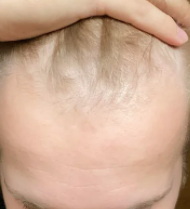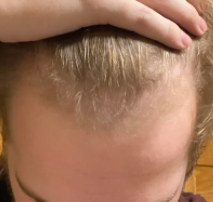I have no preference. Only about 40% of men are minoxidil responders and when they do respond, they respond to both the topical and the oral. The topical keeps it local
I have been thinning slowly on the top of my head for about 7 years or more. I am guessing that the hairs that started to minituarize 7 years ago are too late to reverse and make strong again with finasteride? But the hairs that started to miniaturize say 2 years ago there can be hope to save them?
Perhaps there is no hard truth to this that applies to everyone?
Miniaturization is generally the end stage of hair loss for those particular miniaturized hairs. Miniaturization comes in ‘many flavors’, for example, one could lose 20, 40, 60 80% of the original thickness of the hair shaft and all of these are called miniaturized hairs. When the ,more advanced miniaturized hairs fall out, the longer that they are out, the less chance that these hairs will regrow. Finasteride can move a miniaturized hair from 40% miniaturization to say 20% miniaturization. I have seen miniaturized hairs hang in with 95% of their hair thickness gone. When these fall out, the never return.
I’ve been using dutasteride for more than 4 years with good results initially. My hairline got a bit stabilized after hoping onto dutasteride and minoxidil. Recently, I’m noticing more hair in shower and in room and my hairline is still receding, hair becoming thinner, although slowly. Has anyone else noticed the same? This is fucking frustrating to see the hair loss in 20s even with the best possible treatment available. I guess the hair transplant is the only other option left for me.
As hair is lost more in your younger years, the hairs that you lose when you are older are often less responsive to drugs like finasteride or dutasteride.
Hi doctor, i have few questions (not regarding your new treatment) am just little inquisitive about hair science with regard to Prolactin and genetic hair loss and have some questions regarding that I hope you answer
Prolactin Inhibition of hair growth is reported to occur via catagen induction. This is an interesting question: Neurohormone mainly secreted in anterior pituitary gland. PRL signaling occurs via the prolactin receptor (PRL-R). PRL and PRL-R are widely expressed across different tissues, including the HF. Next to its essential function in promoting lactation, PRL plays a role in metabolic homeostasis, regulation of growth and is hypothesized to suppress apoptosis
This is all theory and we don’t know what we should do about it at this time.
I’m 22 (gonna be 23 in about a month) norwood 2.5 and overall thin hair and I think fin is my only option but every hair restoration clinic I’ve been to warns against it due to my age and the side effects. Yet I see a lot of people here saying they received zero sides and about the same amount of people calling it poison. I wanna try maybe 0.25 every other day to see if that would make a difference? But I know if I go to my gp to get a prescription they’ll probably advocate against it too. Even if I don’t get sides I’m afraid all the negativity around it will nearly make me convince myself I’m getting sides. My main fear is the ED and decreased libido it’s not something I want to have in a relationship. Also heard that it could affect the health of your sperm. I’m constantly going back and forth on the topic.
My son went on finasteride and got an increased sex drive, which I hear on occasion here on Reddit. You are correct, if you talk yourself into side effects, you will get them. The nocebo effect can cause you problems, Speak with your doctor and listen to what he tells you.
I’m currently on 1mg oral min & 0.5mg oral fin. If I drop the min to 0.5mg, will I retain the gains made? I have been on my current protocol for about 8 months.
The 0.5mg dose is 80% as effective as the full dose of finasteride. So yes, you can drop the dose and probably will not see any problems from doing so
I saw a redditor claim that transplants are very complicated and prone to poor results whenever your native hairline is already dense. In other words, someone like myself could not achieve a natural looking result, even with my long hairstyle, because my current hair is already quite dense and no transplant could hope to replicate that density. Please tell me this isn’t isn’t true – I am looking into temple transplants in the near future to even out my mature hairline (which rest assured looks quite high from the front).
Thank you for your time, doctor.
Hair transplant density can be whatever you want it to be. To get back to the original density (something I rarely ever do), it takes more than one surgery because follicular units are generally 1mm apart for a typical Caucasian male. I like to use this post to show what I consider a dense hairline; however, this hairline has about 50% of its original density which is usually adequate for most men. See here: https://baldingblog.com/repair-of-hairline-transplants-photos/
That depends upon the stage progression in the pattern of balding that a person has. Also age is a factor as men over 40 often don’t need finasteride with a hair transplant
At what age does hair loss usually “stabilize”, asks a Reddit poster?
It’s all tied to genetics. The time it appears, how long it lasts, what pattern of balding you develop and the time it takes to get there. Medications like finasteride and sometimes minoxidil slow it down or stop it for a long period of time. If your lucky, it reverses.
Since I realized that my hair was getting thinner, I started paying more attention to other people’s hair. Much to my surprise, there are a lot of older folks whose hair receded and thinned, but they are not bald. This includes most of my family and gives me hope. For example, if you look at my older (>60) relatives, they have pretty much hair, but when I compare their hair to mine, theirs are much more thinner and receded.
I reported a few years ago, a condition we called “Age Related Thinning” which defines the changes in the thickness of all of the scalp hair to become finer. We see this clearly in many post menopausal women and in men. In fact, my hair became significantly finer when I became 60.
I’ve been taking it for almost a month now and haven’t experienced any side effects! Should I expect to see them?
You are typical. Most men do not see anything wrong with the many side effects reported unless you talk yourself into them. The real incidence of sexual side effects, for example, is under 4%
“If you’ve been prescribed Finasteride by your doctors but you’re scared to take Finasteride, give this a read.
I am not a Doctor, I am not asking you to start Finasteride. If you’ve been prescribed but are afraid to start and/or want to avoid nocebo read this.
Read this everyday for 2-3 weeks. Basically will be brainwashing yourself from the fears.
Again do not start because of this report. This collation is to help you start if you’re feeling scared despite being prescribed by your Doctor.
People do get sides. The sides are real but only a small percentage get sides. And even if you get sides, you can stop taking Finasteride / lower your dose.
As pointed in the comments
I did get some slight sides after 3 months and 15 days of usage. I took a break for 4 days and they all went away.
I tapered down the dose and I’m doing absolutely fine ever since. I now take 0.5mg EOD (Every Other Day)
I’ve been considering going down the Topical route too.
The point of the post is – Some people do get sides but you mostly will not. *If you’ve been prescribed by your Doctor, I want to reduce the fear you have, that’s all.”
I am the doctor who pioneered FUE between 1996-2002, publishing the first journal article on the subject in 2002 as a result of 6 years of experimental work with many cooperative patients. I am the original inventor of he hair transplant robot holding two US Patents on it. I licensed the robot technology to Restoration Robotics, who made the ARTAS and we eventually purchased one, using it for a few years, eventually selling it. We found that the manual systems that were developed after the commercial robot were fully developed allowed us to perform FUE faster and more accurate than the ARTAS. Speed was important. Also, we found that the transection rate was higher with the ARTAS than with the good manual systems so we focused on the best of the manual system. We purchase every manual system available to compare one to the other and eventually found that some worked better in some situations and others in other situations. Having many types of manual systems allows us to always use the best system for our patients.
Page 92 of 1234



